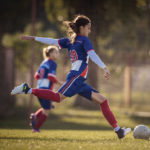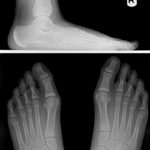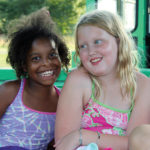
Children in the experimental group run through part of the motor skills intervention. (Photo courtesy of Leah Ketcheson, PhD.)
Intense therapy creates quick gains
By Peaches Scribner
Intense motor skills interventions in young children with autism spectrum disorder (ASD) can significantly improve locomotor and other lower extremity skills in addition to socialization behaviors, according to a recent pilot study.
Most evidence-based interventions for young children with ASD target core deficits in social and communication domains, but ASD-related motor delays emerge as early as age 6 months. Motor skills therapies can address these deficits before others emerge, said lead author Leah R. Ketcheson, PhD, director of operations at LightUp.Shine.Now, an organization in Ann Arbor, MI, providing research-informed programs to individuals with special needs.
“Motor skills interventions have cascading effects toward secondary domains and can result in a host of positive outcomes in communication and social skills,” she said.
The study included 20 kids aged 4 to 6 years with ASD; 11 received an eight-week motor skill intervention four hours a day, five days a week, with a 1:1 instructor-to-child ratio. Nine children in the control group were instructed to continue typical activity and did not receive the intervention; both groups underwent speech, occupational, and social skills therapy.
Strategies from Classroom Pivotal Response Teaching (CPRT), an evidence-based therapeutic model designed for teachers and paraeducators, provided the framework. Investigators tested children in familiar places, such as playgrounds or fields. Allowing children to choose their favorite ball color and size and using fun games such as kicking a ball around cones and modified relay races appealed to the children and kept them engaged.
Ketcheson and colleagues used the Test of Gross Motor Development-2 (TGMD-2) biweekly to measure locomotor skills (eg, running, hopping, jumping) and object control skills (eg, striking a stationary ball, stationary dribble, catching, kicking, throwing).
After only two weeks, the children in the experimental group demonstrated a significant increase in locomotor and object control skills and in gross quotient (a composite measure of both skills categories). Participants’ locomotor improvements plateaued between weeks four and eight, and object control skills improved during the first two weeks but demonstrated nonsignificant changes between weeks two and four, four and six, and six and eight. A significant gain in locomotor skills also occurred between weeks four and eight.
The researchers assessed socialization changes in the experimental group every other week during the intervention. Significant improvements were achieved in proximity and peer-to-peer engagement, but not across all domains. Children spent significantly less time in solitary activities, and time effects approached significant changes in two domains.
Retention of improvements was high for motor skills and socialization skills one week postintervention, with only a slight drop when measured at four weeks. One week postintervention the control group demonstrated slightly improved motor outcomes, but these changes weren’t sustained through the fourth week. Ketcheson attributed the temporary change to test and tester familiarity.
To describe physical activity (PA) for both groups, researchers used an accelerometer, capturing pre- and postintervention data at weeks one and four. Although PA changes were nonsignificant, both groups met or exceeded guidelines for moderate and vigorous PA recommendations of 60 minutes a day but were sedentary for at least eight hours a day.
Autism epublished the results in June.
“Improvements took much less time than we thought,” Ketcheson said. “Most changes occurred in the first four weeks, indicating that intensity is needed only as initial therapy, with maintenance therapy requiring an hour a week.” Follow-up can be done realistically in a variety of settings without being burdensome, she said.
“What is exciting about Dr. Ketcheson’s findings is that, with the right support and instruction we can improve motor skills very early, and in a fun and playful atmosphere that will keep children engaged,” said Megan MacDonald, PhD, assistant professor in Movement Studies of Disability at Oregon State University in Corvallis. MacDonald studies similar interventions for children with disabilities. (See “Early focus on gross motor skills may benefit children with autism,” August 2014, page 6.)
This therapy can be delivered in a classroom setting or during summer sessions and vacation time, through community centers, in gym spaces, and on sports fields, making it widely accessible, said Ketcheson. She hopes to narrow the gap between ASD diagnosis and treatment, which can be as long as a year.
Children with ASD often have associated conditions such as hypotonia, or they may be diagnosed with other disabilities affecting muscle strength and coordination. Ketcheson said the CPRT framework can be effective as a foundation for other therapies or be implemented simultaneously.
Early childhood is a sensitive time in development, and motor researchers have an opportunity to improve motor skills very early—even as young as 2 years, said Ketcheson. Early intervention may give children with ASD the ability to play and interact in age-appropriate ways with their peers entering kindergarten. Early intense motor skills instruction within a CPRT framework can be a valuable addition to practitioners’ intervention strategies aimed at improving social success for children with ASD, she said.
Peaches Scribner is a freelance writer in Washington, DC.
Source:
Ketcheson L, Hauck J, Ulrich D. The effects of an early motor skill intervention on motor skills, levels of physical activity, and socialization in young children with autism spectrum disorder: a pilot study. Autism 2016 June 26. [Epub ahead of print]




